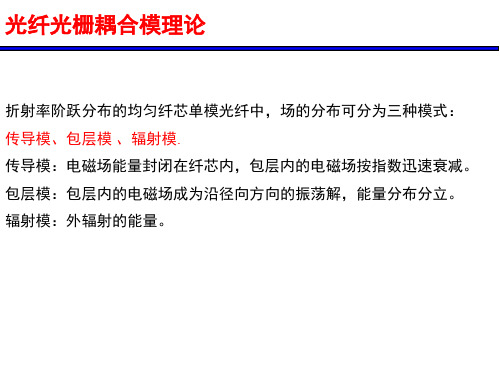耦合模理论
《耦合理论》课件

有限差分法
总结词
有限差分法是一种将偏微分方程离散化 为差分方程的方法。
VS
详细描述
有限差分法通过将连续的时间和空间变量 离散化为有限个离散点,并使用差分近似 代替微分,将偏微分方程转化为离散的差 分方程组。然后,使用迭代或其他数值方 法求解该差分方程组,以获得近似解。
谱方法
总结词
谱方法是一种基于傅里叶级数或其它正交多 项式展开的数值方法。
详细描述
在电路中,耦合现象通常表现为信号的传递 和干扰。例如,变压器、电感和电容等元件 之间存在电磁耦合,这些耦合会导致信号的 传输和能量的损失。为了减小耦合效应,工 程师需要合理地设计电路布局和元件参数,
以优化电路性能。
建筑结构的耦合分析
总结词
建筑结构的耦合分析是指将结构视为一个整体,分析其各组成部分之间的相互作用和影 响。
02
根据影响和作用的范围,耦合可以分为局部耦合和全局耦合。局部耦合是指影 响和作用仅限于系统或组件的局部范围,而全局耦合则是指影响和作用遍及整 个系统或组件。
03
根据影响和作用的稳定性,耦合可以分为稳定耦合和不稳定耦合。稳定耦合是 指影响和作用在长时间内保持稳定,而不稳定耦合则是指影响和作用随时间变 化而变化。
时空耦合模型是指系统中各部分之间 的相互作用关系不仅与它们的状态变 量有关,还与时间和空间有关。
时空耦合模型在气候变化、地震预测 和城市规划等领域有广泛应用,例如 气候模式和城市交通网络等。
在时空耦合模型中,各部分之间的相 互作用力不仅与它们的状态变量成正 比,还与时间和空间有关,因此系统 状态的演化是时空相关的。
耦合的应用场景
01
在通信系统中,耦合可 以被用于描述信号传输 过程中的能量损失和干 扰现象。
耦合模理论-coupled mode theory

Mode expansion Single-waveguide mode coupling Multiple-waveguide mode coupling Two-mode coupling Codirectional coupling Contradirectional coupling Phase matching
References: This lecture follows the materials from Photonic Devices, Jia-Ming Liu, Chapter 4.
1
Coupled-mode theory
Coupled-mode theory deals with the coupling of spatial modes of different spatial distributions or different polarizations, or both. The normal mode fields spatial dependence in a lossless waveguide at a single frequency can be given as
ˆ ( x, y ) exp(i z ) E (r ) A ( z ) E
ˆ ( x, y ) exp(i z ) H (r ) A ( z ) H
9
Single-waveguide mode coupling
10
Single-waveguide mode coupling
E i 0 H H iE iP
光纤光栅模耦合理论

单模均匀光纤光栅反射谱公式: 光纤光栅布喇格反射公式
光纤光栅耦合模理论
光纤光栅区域的光场满足模式耦合模方程:
dAin0 dz dAin0 dz K n0 m0 Aim0 exp[ j ( n0 m0 ) z ] K n0 m0 Aim0 exp[ j ( n0 m0 ) z ]
t Emt H mt H mz 考虑 j m H mt j0 z 是m模式的播常 H mt 2 m H m t H mz z j 0 n0 Em m zt t z
t (
A z 、B z 分别为光纤光栅区域中的前向波、后向波; k z 为耦合系数;q z 与光栅周期和传播常数 有关。
利用此方程和光纤光栅的折射率分布、结构参量及边界条件, 并借助数值算法,可以求出光纤光栅的光谱特性。
i t i 0 m i m mt i H t bi ' m H mt i ' 0 m
i i 2 t [ t (aim Emt )] z (bim H mt ) j 0 n aim Emt j0 z i0 m i0 m i0 m i
i i 2 t [ t (aim Emt )] z (bim H mt ) j 0 n aim Emt j0 z i0 m i0 m i0 m i
dbim )( z H mt ) j 0 (n 2 n0 2 )aim Emt ] 0 dz i 0 m i daim bim 1 1 {[( jb )( z E ) [( )( H i m m mt t t mt )]} 0 2 2 dz j n n i 0 m 0 0
第六章 模式耦合理论2016

K 21
6 17
上式说明了一个有趣的现象,光波功率在光纤1和光纤2之间周期性 sin 2 Kz 1 交换(结论二),如果 ,则光功率完全耦合到光纤 2中。
(6-15)式 和(6-16)式的结果只能说是耦合模方程的形式解,因为在所 得结果中,有两个重要的参数,即耦合参数K12和K21并未给出。 严格求解这两个系数是非常困难的,简化的过程如下。 如右图示,将整个光纤耦合系 统分成三个区域。 如前所述,弱耦合条件下,可 认为波导1和波导2内的场分别为
6 9
K12 和 K 21是耦合系数,它们直接决定了光纤1和光纤2之间相互影响
的大小。一般说来,耦合系数都是复数,并且可以采用Lorentz互易 定理证明它们具有如下互易特性
* K12 K 21
利用 (6-8)式和耦合方程(6-9)式,可以得到
dA1 z j z jK 21 A2 z e 1 2 dz dA2 z jK A z e j 2 1 z 12 1 dz
K 21 1 B a 1 2 1 K a2 B 1 a K 21 a 2 2 1 2 K
6 9
6 14
a2 0 如果再令初始条件 ,则可将上式简化为
j z a1 z a1 cos Kze j z a2 z a1 sin Kze
•2. 模式的横向耦合理论
到另一根光纤中光波场的影响。 为分析两根相互靠近的光纤 的影响,首先假设两根光纤单独 存在时的场量分别为 a.)只有波导1存在时
1 j z E10 e 1 E1 2 j z 1 E10 e 1 j z H10 e 1 H1 2 j z 1 H10 e
model coupling theory

model coupling theory模型耦合理论(Model Coupling Theory)是指将不同的模型或子模型通过某种方式相互连接,形成一个整体模型的理论和方法。
它旨在解决多个模型之间相互依赖、相互影响的问题,以及提高模型的准确性和可靠性。
模型耦合理论的基本思想是将多个模型组合成一个整体模型,使得各个子模型之间可以相互传递信息、相互影响,并通过协同作用达到更准确的结果。
模型耦合可以是线性的、非线性的,也可以是静态的、动态的。
在模型耦合理论中,常用的耦合方式有以下几种:1. 驱动-响应耦合(Driver-Response Coupling):一个模型作为主模型,驱动其他模型的运行,并根据其他模型的响应进行调整。
这种耦合方式常用于模拟系统的控制过程。
2. 数据耦合(Data Coupling):不同模型之间通过共享数据进行耦合。
模型之间的数据交换可以是单向的或双向的,可以是离散的或连续的。
3. 参数耦合(Parameter Coupling):不同模型之间通过共享参数进行耦合。
一个模型的输出可以作为另一个模型的输入参数,或者两个模型共享相同的参数。
4. 接口耦合(Interface Coupling):不同模型之间通过定义共同的接口进行耦合。
接口定义了模型之间的输入和输出,使得模型之间可以进行交互。
模型耦合理论的应用非常广泛,包括气候模型、生态模型、经济模型等领域。
通过将不同的模型耦合起来,可以更好地模拟和预测复杂系统的行为,提高决策的科学性和准确性。
然而,模型耦合也带来了一些挑战,如模型之间的数据一致性、模型之间的计算效率等问题,需要进一步研究和解决。
光纤耦合器的理论_设计及进展

第30卷第1期 2010年3月物 理 学 进 展PROGRESS IN PH YSICS V ol.30No.1 M ar.2010文章编号:1000-0542(2010)01-0037-44收稿日期:2009-11-18基金项目:国家自然科学基金(10674075,10974100,60577018)、天津市应用基础与前沿技术研究计划重点项目、国家863计划项目(2006A A01Z 217)、光电信息技术科学教育部重点实验室开放基金项目资助*Ema il:zhangw g@nanka 光纤耦合器的理论、设计及进展林锦海,张伟刚(南开大学现代光学研究所,光电信息技术科学教育部重点实验室,天津300071)摘要: 系统总结了光纤耦合器的发展历程,归纳提炼出各个阶段的标志性事件;详细阐述了光纤耦合器的耦合类型、制作方法、性能参数;详细评述了光纤耦合器的理论分析方法;全面分析了X 型、星型、光栅型、混合型等各种典型光纤耦合器的基本结构、工作原理及耦合特性;指出并展望了光纤耦合器的发展方向和应用前景。
作者率先提出并设计了超长周期光纤光栅耦合器,实验上实现了两个超长周期光纤光栅之间的有效耦合。
关键词:光纤光学;光纤耦合器;光纤通信;光纤传感;超长周期光纤光栅中图分类号:T N253;T N929 文献标识码:A0 引言光纤耦合器是一种用于传送和分配光信号的光纤无源器件,是光纤系统中使用最多的光无源器件之一,在光纤通信及光纤传感领域占有举足轻重的地位。
光纤耦合器一般具有以下几个特点:一是器件由光纤构成,属于全光纤型器件;二是光场的分波与合波主要通过模式耦合来实现;三是光信号传输具有方向性。
根据光的耦合原理,人们已经设计出了多种光纤耦合器器结构。
包括:X 型光纤耦合器、星型光纤耦合器、双包层光纤耦合器、光纤光栅耦合器、长周期光纤光栅耦合器、布拉格光纤耦合器、光子晶体光纤耦合器等。
随着各种光纤通信和光纤传感器件的广泛使用,光纤耦合器的地位和作用愈来愈重要,并已成为光纤通信和光纤传感领域不可或缺的一部分。
无线电传输在双线圈及四线圈系统中的耦合模理论

Transmission of Wireless Power in Two-Coil and Four-Coil Systems using Coupled Mode TheoryManasi Bhutada, Vikaram Singh, ChiragWartyDept. of Electrical and Electronics EngineeringIntelligent Communication LabMumbai, India无线电传输在双线圈及四线圈系统中的耦合模理论电气与电子工程系智能通信实验室印度,孟买姓名:学号:班级:日期:2016年7月2日Abstract—Wireless Power Transfer (WPT) systems are considered as sophisticated alternatives for modern day wired power transmission. Resonance based wireless power delivery is an efficient technique to transfer power over a relatively long distance. This paper presents a summary of a two-coil wireless power transfer system with the design theory, detailed formulations and simulation results using the coupled mode theory (CMT). Further by using the same theory, it explains the four-coil wireless power transfer system and its comparison with the two-coil wireless transfer power system. A four-coil energy transfer system can be optimized to provide maximum efficiency at a given operating distance. Design steps to obtain an efficient power transfer system are presented and a design example is provided. Further, the concept of relay is described and how relay effect can allow more distant and flexible energy transmission is shown.摘要——无线电源传输(WPT)系统被认为是复杂的现代有线输电的替代品。
7耦合模理论及器件

Lo / 2k
耦合长度,在其奇数倍长度 处也可实现完全耦合
光耦合器件
一.光耦合器 二.Mach-Zehnder干涉仪 三.Mach-Zehnder型电光调制器 四.Interleaver光滤波器 五.微环谐振滤波器 六.有机聚合物微谐振环电光调制器
光耦合器件(一)——耦合器
• 功能:对同一波长的光功率进行分路或合路 • 类型:Y型、X型22耦合器、1N型、MN型 • 分类:
已知
u, v, z
缓变函数传输常数场 Nhomakorabea程2 t2 n k0 n0 n n 0 2 2
n
m
2 k0 n2 0
2
n n *ds 1
S
模式展开
模式的完备性
(u, v, z) Anp ( z) np (u, v) exp jpn z , p
光纤耦合器的散射矩阵表示法
a1 ( z ) jz cos(kz) a ( z ) e j sin(kz) 2
2 2
j sin(kz) a1 (0) cos(kz) a2 (0)
2
a2 ( z ) sin (kz ) a1 (0)
a1 ( z ) cos (kz ) a1 (0)
2 2
2
a2 ( z ) sin (kz ) a1 (0)
2 2
2
传输功率在两个波导之间周期性交替传递
a2 ( z ) sin (kz ) a1 (0)
2 2
2
a2 ( L ) sin 2 (kL) a1 (0)
光从波导1完全耦合至波导2的长度为
2 q k0 dAm pq pq j kmn Anp exp j qm p n z kmn 2 pm dz n, p
- 1、下载文档前请自行甄别文档内容的完整性,平台不提供额外的编辑、内容补充、找答案等附加服务。
- 2、"仅部分预览"的文档,不可在线预览部分如存在完整性等问题,可反馈申请退款(可完整预览的文档不适用该条件!)。
- 3、如文档侵犯您的权益,请联系客服反馈,我们会尽快为您处理(人工客服工作时间:9:00-18:30)。
耦合模理论及其在微波和光纤技术中的应用(研究生课程用)钱景仁中国科学技术大学二零零五年目录绪言 (Preface) (1)第一章耦合模的一般理论§1.1 耦合模方程 (6)§1.2 强耦合与弱耦合 (11)§1.3 周期性耦合 (18)§1.4 耦合模与简正模 (29)§1.5 缓变参数情况下本地简正模广义理论 (33)§1.6 理想模、本地简正模和超本地简正模 (37)§1.7 耦合器应用举例 (42)§1.8 临界界面附近和稳相点附近的耦合模方程 (46)第二章闭合波导中的耦合模问题§2.1 介质填充波导 (51)§2.2 缓变表面阻抗和阻抗微扰 (59)§2.3 弯曲波导 (64)第三章光纤中的耦合模问题§3.1 光纤中的简正模式 (68)§3.2 耦合模理论的推广 (80)§3.3 非理想光纤的耦合模方程 (81)§3.4 用闭合波导理论来研究开波导 (86)第四章 螺旋光纤及弯曲光纤§4.1 螺旋光纤的耦合模分析 (89)§4.2 单模传输条件下的螺旋光纤 (93)§4.3 弯曲光纤 (98)第五章耦合功率方程§5.1多模波导和多模光纤的传输特性 (104)§5.2 多模波导中的耦合功率方程 (105)§5.3 多模光纤传输中的耦合功率方程 (107)中文参考文献 (109)英文参考文献 (110)PrefaceWhat is the coupled-mode theory? Is it a common theory in physics?Waves and vibration phenomena are popular in physics as we know such as mechanical vibrations, acoustic waves, light waves, microwaves and radio waves. Furthermore, connection or coupling among systems is also a general rule in universe. Everything presupposes the existence of some other thing. Cause-effect relations and action-reaction relations are generally existed among systems in the universe.It is obvious that there aren’t any ideal waves which exist independently and do not change their amplitudes and directions. A real wave or vibration is always connected with a source or other waves. Now, it is necessary to describe how these waves or vibrations (oscillations) couple to each other, and how their amplitudes change with the time or the distance. To illustrate the principle of the coupling between waves or vibrations (oscillations), let’s take pendulums as an example.Fig. aA pendulum can vibrate, that is to say it swings from side to side. We can give it a push and then it will vibrate at a fixed speed or at a certain frequency. If two pendulums with same frequency are hung on a string and one of them is set swinging as shown in Fig. a, it will swing less and less until it stops altogether, while the other pendulum will swing higher and higher until it reaches a maximum. Then the process will be reversed until the first pendulum reaches a maximum and the second comes torest once more. This cycle repeats itself again and again. It would repeat infinitely ifthere were no losses in the system.This is a typical experiment performed in most early physics courses. I had done it when I was in middle school.1Fig. b Frequencies are the same. Fig. c Frequencies are different.If these two pendulums have different frequencies, then transfer of energy between them will not be complete, and the first pendulum will not stop in the process. We can plot a graph to express the process as shown in Fig.b and Fig.c. The abscissa represents the time, and the ordinate A represents the amplitude of each pendulum. If the initial conditions at t =0 are as follows:()()1201,00A A ==,We can see the variations of the amplitudes of the two coupled pendulums in Fig.b and Fig.c, respectively, when their frequencies are the same and different. The time spacing between two adjacent maxima (or minima) is the period of the process, which is determined by the coupling between the two pendulums. The stronger the coupling is, the shorter the period is. The coupling between the two pendulums is caused by the fact that the pendulums are connected to a same string, and any vibration of one of the pendulums will have an effect on the other through the string.It has been recognized that coupled transmission lines, coupled electrical circuits, coupled optical fibers and coupled waveguides are analogous to coupled pendulums. The variations of the amplitudes of waves are the same as shown in the figures, but now the abscissa represents distance instant of time.Sometimes the coupling is not between the same kind of waves or oscillations, for example, in a traveling wave tube, a space-charge wave and an electromagnetic wavecouple to each other. In a crystal, an electrical vibration will cause a mechanical (or acoustic) vibration and vice versa.There should be some general rules or there is a generalized theory to describe these coupling problems. It is the so called coupled-mode theory. Here, mode means one of the models of wave forms.In the theory, all the coupled-mode or coupled-vibration problems are formulated by a set of coupled-mode equations, which are simultaneous differential equations of first order with variable or constant coefficients. In case of two modes, they can be written as follows:()()()()()()11122221j j j j dA z A z cA z dz dA z A z cA z dz ββ=−+=−+Where i β and c are functions of z in general case.When n modes or waves should be considered in a coupling problem, n differential equations will be used instead of two.A common method in electromagnetic theory is the modal approach in which the normal modes of the system (those fields which propagate unchanged except in phase) are found. This involves solving the wave equation adapted to the particular geometry of the system, and matching solutions at the boundaries to give the normal modes or eigensolutions. Any field of the system can then be expanded in terms of the normal modes, with the expansion coefficients determined by certain boundary conditions e.g. initial conditions. This modal-expansion or eigenvector method is physically intuitive and straightforward in principle, but modal solutions of the wave equation can only be found for a limited number of ideal systems of relatively simple geometry, including slabs and circular cylinders.Coupled-mode theory attempts to preserve the concept of modes for non-ideal systems in which an exact modal solution is not possible but where the normal modes of a reference system of simple geometry are known. These modes, in general, form a complete set so that they can be used to expand the fields of the non-ideal system.Because they do not satisfy the boundary conditions of the non-ideal system, the modes coupled or exchange power as they propagate. To derive the coupled-mode equations, Maxwell’s equations are transformed to those which determine how the individual mode amplitudes vary as a function of the parameters of the system. There have been several methods of coupled-mode analysis to formulate the coupled-mode equations. In the early times, people used to start directly from Maxwell’s equations along with the boundary conditions to derive these equations. Later, many other methods were utilized, such as using reciprocity theorem, starting from a Green function or stimulating equations of waveguides, someone also used variation method and perturbation approach, all these are substantial agreement.The method of coupled-modes is most useful when the deviation of the non-ideal system from the known reference system is not too great e.g. small deviations in refractive index or small deformation of cross-section. Although the imperfections may be small they can still produce marked effects, such as total transfer of power from one mode to the other in a waveguide or one waveguide to another. Coupled-mode theory has also been used to treat a variety of problems, including the cross-sectional deformation of waveguides. In many of the problems where the power transfer between modes is small, solutions can also be obtained by other techniques. However, coupled-mode theory has particular application to systems in which a large fraction of modal power may be transferred to other modes, as in the case of neighbouring waveguides in which complete transfer of power between waveguides can take place. This is unique for coupled-mode theory.The primary idea of the coupled-mode theory was first introduced by Pierce in 1940’s, when he worked on microwave electronic devices. Later, this idea was extended its use to the waveguide transmission by Miller and then the theory was fully developed. Recently, the theory has been widely used to solve optical fiber transmission problems and fiber gratings. On the other hand, the coupled-mode theory supervises the practice and many new coupling principles have been discovered. According them, a variety of devices have been designed, such as mode transducers, broadband optical fiber couplers and etc.A lot of coupling problems involving optics, acoustics and microwaves have been being solved by scientists of many countries, including Chinese scientists. Prof. Huang Hong-Chia, vice-president of Shanghai University, has made important contributions to coupled-mode theory. Some of his papers are listed in the end of this book for reference.In this book, the first chapter begins with the coupled-mode equations and is followed by many treatments to solve these equations. In Chapter 2, many typical coupled-mode problems in closed waveguides are solved. Those all problems will lead to the coupled-mode equations and then the coupling coefficients are derived. Chapter 3 begins with a discussion of the normal modes in optical fibers. The remainder of the chapter deals with coupling between these normal modes in imperfect optical fibers. In Chapter 4 helical fibers and bending fibers are studied. In the fifth chapter the coupled power theory is introduced, it consists of Pierce’s theory and Marcuse’s theory which are used in waveguide and optical fiber transmission, respectively.On the whole, coupled-mode theory is a general theory. Mathematically, it bases on the expansion theorem of eigen-functions, the existence of expansion in terms of eigen-functions makes the theory to be carried out. The mathematic areas in the theory are differential equations and linear algebra.第一章 耦合模的一般理论在这一章中,将首先从一般概念出发,得到耦合模方程。
